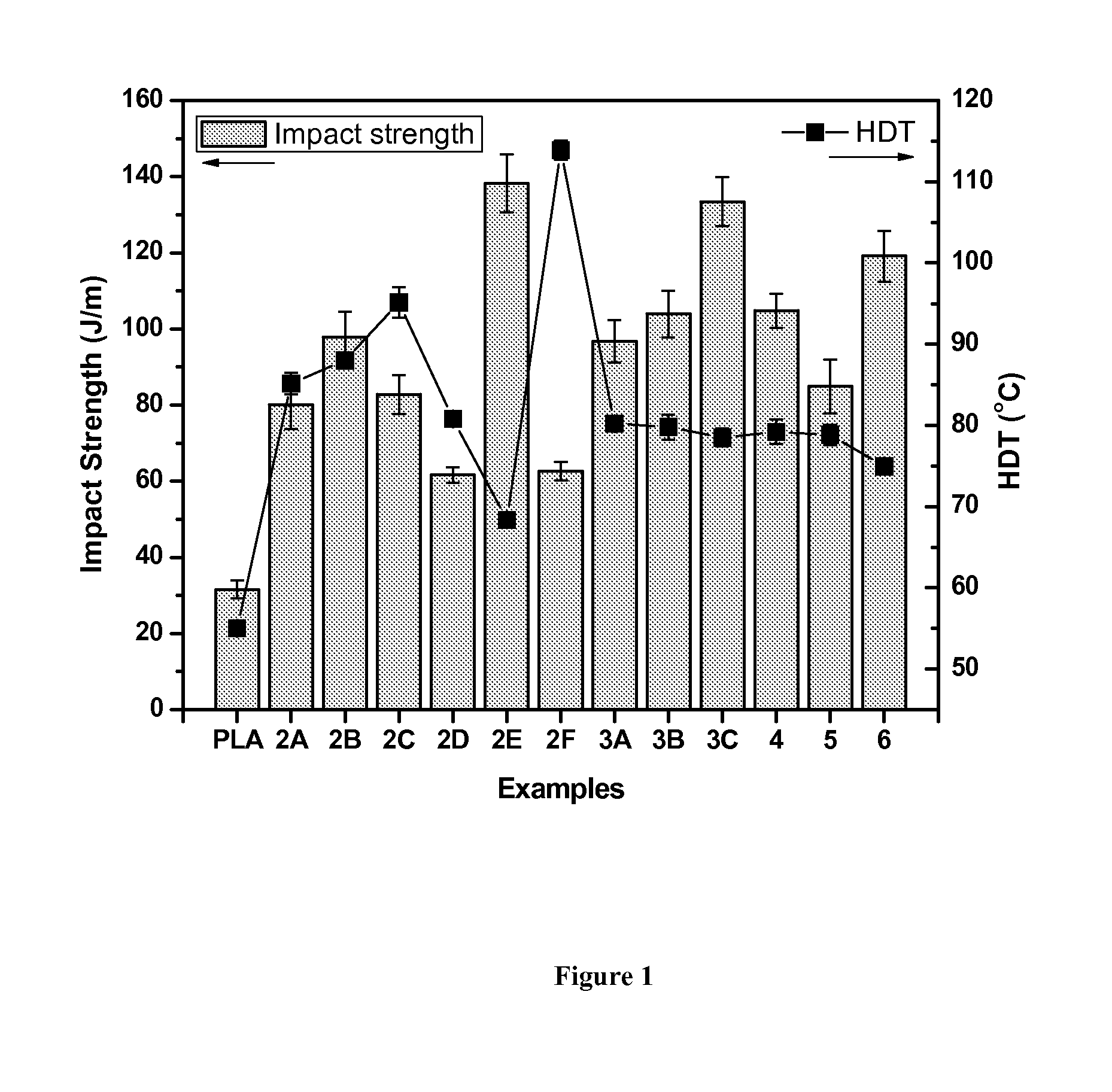Poly (lactic acid)-based biocomposite materials having improved toughness and heat distortion temperature and methods of making and using thereof
a biocomposite material and polymer technology, applied in the field of polylactic acid blends, can solve the problems of high cost, high cost, and high cost of chemical modification, and achieve the effects of improving toughness, impact strength, and improving toughness
- Summary
- Abstract
- Description
- Claims
- Application Information
AI Technical Summary
Benefits of technology
Problems solved by technology
Method used
Image
Examples
example 1
Preparation of PLA Blends
[0113]A PLA-based blend was prepared having the following composition: (a) 70 wt % PLA (Ingeo® 3001 D), (b) 20 wt % functionalized polyolefin copolymer (Lotader® AX8900) and (c) 10 wt % thermoplastic elastomeric segmented block copolymer (Pebax® Rnew 35R53). This blend is referred to as Example 1A in Table 1.
[0114]A second blend was prepared having the following composition: (a) 70 wt % PLA (Ingeo 3001 D), (b) 20 wt % functionalized polyolefin copolymer (Lotader® AX8900) and (c) 10 wt % thermoplastic elastomeric segmented block copolymer (Hytrel® 3078). This blend is referred to as Example 1B in Table 1.
[0115]The blends were prepared by extrusion followed by injection molding in lab scale processing machines. The extrusion temperature was 190° C. and injection temperature was 190° C. The mold temperature was 30° C. The cooling time was 30 seconds.
example 2
Preparation of PLA Composites Containing PLA Blend, Natural Fibers and Nucleating Agent
[0116]PLA composite 2A in Table 1 was prepared by combining the following materials: (a) 89 wt % of PLA blend 1A; (b) 10 wt % of natural fiber (miscanthus); and (c) 1 wt % nucleating agent (LAK-301). The composites were manufactured in lab scale processing machines with an extrusion temperature of 190° C. and upon injection molding, the injection temperature was 190° C., the mold temperature was 110° C., and the cooling time was 60 seconds.
[0117]PLA composite 2B in Table 1 was prepared by combining the following materials: (a) 84 wt % of PLA blend 1B; (b) 15 wt % of natural fiber (oat hull); and (c) 1 wt % nucleating agent (LAK-301). The composites were manufactured in lab scale processing machines with an extrusion temperature of 190° C. and upon injection molding, the injection temperature was 190° C., the mold temperature was 110° C., and the cooling time was 60 seconds.
[0118]PLA composite 2C i...
example 3
Preparation of PLA Composites Containing PLA Blend, Natural Fiber, Nucleating Agent, and Chain Extender
[0122]PLA composite 3A was prepared by combining the following materials: (a) 87 wt % of PLA blend 1A; (b) 10 wt % natural fiber (miscanthus); (c) 1 wt % nucleating agent (LAK-301) and (d) 2 wt % chain extender (BioAdimide 500 XT). The composites were manufactured in lab scale processing machines with an extrusion temperature of 190° C. and upon injection molding, the injection temperature was 190° C., the mold temperature was 110° C., and the cooling time was 60 seconds.
[0123]PLA composite 3B was prepared by combining the following materials: (a) 82 wt % of PLA blend 1B; (b) 15 wt % natural fiber (oat hull); (c) 1 wt % nucleating agent (LAK-301), and (d) 2 wt % chain extender (BioAdimide 500 XT). The composites were manufactured in lab scale processing machines with an extrusion temperature of 190° C. and upon injection molding, the injection temperature was 190° C., the mold temp...
PUM
| Property | Measurement | Unit |
|---|---|---|
| heat distortion temperature | aaaaa | aaaaa |
| average molecular weight | aaaaa | aaaaa |
| average molecular weight | aaaaa | aaaaa |
Abstract
Description
Claims
Application Information
 Login to View More
Login to View More - R&D
- Intellectual Property
- Life Sciences
- Materials
- Tech Scout
- Unparalleled Data Quality
- Higher Quality Content
- 60% Fewer Hallucinations
Browse by: Latest US Patents, China's latest patents, Technical Efficacy Thesaurus, Application Domain, Technology Topic, Popular Technical Reports.
© 2025 PatSnap. All rights reserved.Legal|Privacy policy|Modern Slavery Act Transparency Statement|Sitemap|About US| Contact US: help@patsnap.com

